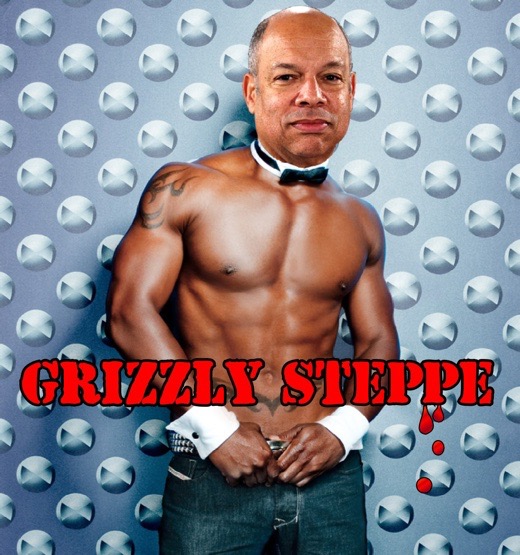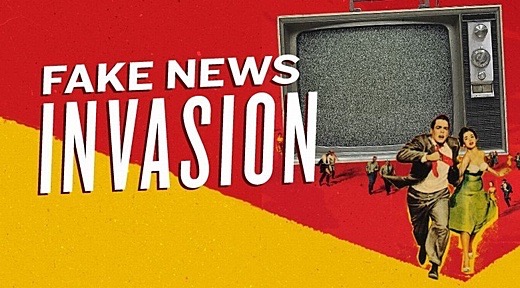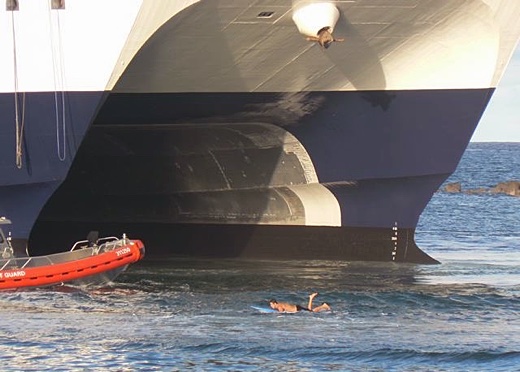SUBHEAD: A review of last year's predictions for 2016 and some new predictions for 2017.
By John Michael Greer on 28 December 2016 for the Archdruid Report -
(
http://thearchdruidreport.blogspot.com/2016/12/a-leap-in-dark.html)
 Image above: Photo of two who leap into the dark. From (https://www.flickr.com/photos/stuant63/3152875867/in/photostream/).
Image above: Photo of two who leap into the dark. From (https://www.flickr.com/photos/stuant63/3152875867/in/photostream/).
A few days from now, 2016 will have passed into the history books. I know a fair number of people who won’t mourn its departure, but it’s pretty much a given that the New Year celebrations here in the United States, at least, will demonstrate a marked shortage of enthusiasm for the arrival of 2017.
There’s good reason for that, and not just for the bedraggled supporters of Hillary Clinton’s failed and feckless presidential ambitions.
None of the pressures that made 2016 a cratered landscape of failed hopes and realized nightmares have gone away.
Indeed, many of them are accelerating, as the attempt to maintain a failed model of business as usual in the teeth of political, economic, and environmental realities piles blowback upon blowback onto the loading dock of the new year.
Before we get into that, though, I want to continue the annual
Archdruid Report tradition and review the New Year’s predictions that I made at the beginning of 2016. Those of my readers who want to review the original post will find it
here. Here’s the gist.
“Thus my core prediction for 2016 is that all the things that got worse in 2015 will keep on getting worse over the year to come.
The ongoing depletion of fossil fuels and other nonrenewable resources will keep squeezing the global economy, as the real (i.e., nonfinancial) costs of resource extraction eat up more and more of the world’s total economic output, and this will drive drastic swings in the price of energy and commodities—currently those are still headed down, but they’ll soar again in a few years as demand destruction completes its work.
The empty words in Paris a few weeks ago will do nothing to slow the rate at which greenhouse gases are dumped into the atmosphere, raising the economic and human cost of climate-related disasters above 2015’s ghastly totals—and once again, the hard fact that leaving carbon in the ground means giving up the lifestyles that depend on digging it up and burning it is not something that more than a few people will be willing to face.
“Meanwhile, the US economy will continue to sputter and stumble as politicians and financiers try to make up for ongoing declines in real (i.e., nonfinancial) wealth by manufacturing paper wealth at an even more preposterous pace than before, and frantic jerryrigging will keep the stock market from reflecting the actual, increasingly dismal state of the economy.
We’re already in a steep economic downturn, and it’s going to get worse over the year to come, but you won’t find out about that from the mainstream media, which will be full of the usual fact-free cheerleading; you’ll have to watch the rates at which the people you know are being laid off and businesses are shutting their doors instead.”
It’s almost superfluous to point out that I called it. It’s been noted with much irritation by other bloggers in what’s left of the peak oil blogosphere that it takes no great talent to notice what’s going wrong, and point out that it’s just going to keep on heading the same direction.
This I cheerfully admit—but it’s also relevant to note that this method produces accurate predictions. Meanwhile, the world-saving energy breakthroughs, global changes in consciousness, sudden total economic collapses, and other events that get predicted elsewhere year after weary year have been notable by their absence.
I quite understand why it’s still popular to predict these things: after all, they allow people to pretend that they can expect some future other than the one they’re making day after day by their own actions.
Nonetheless, the old saying remains true—“if you always do what you’ve always done, you’ll always get what you’ve always gotten”—and I wonder how many of the people who spend each year daydreaming about the energy breakthroughs, changes in consciousness, economic collapses, et al, rather than coming to grips with the rising spiral of crises facing industrial civilization, really want to deal with the future that they’re storing up for themselves by indulging in this habit.
Let’s go on, though. At the beginning of 2016, I also made four specific predictions, which I admitted at the time were long shots.
One of those, specific prediction #3, was that the most likely outcome of the 2016 presidential election would be the inauguration of Donald Trump as President in January 2017. I don’t think I need to say much about that, as it’s already been discussed here at length.
The only thing I’d like to point out here is that much of the Democratic party seems to be fixated on finding someone or something to blame for the debacle, other than the stark incompetence of the Clinton campaign and the failure of Democrats generally to pay attention to anything outside the self-referential echo chambers of affluent liberal opinion. If they keep it up, it’s pretty much a given that Trump will win reelection in 2020.
The other three specific long-shot predictions didn’t pan out, at least not in the way that I anticipated, and it’s only fair—and may be helpful, as we head further into the unknown territory we call 2017—to talk about what didn’t happen, and why.
Specific prediction #1 was that the next tech bust would be under way by the end of 2016. That’s happening, but not in the way I expected. Back in January I was looking at the maniacally overinflated stock prices of tech companies that have never made a cent in profit and have no meaningful plans to do so, and I expected a repeat of the “tech wreck” of 2000.
The difficulty was simply I didn’t take into account the most important economic shift between 2000 and 2016—the de facto policy of negative interest rates being pursued by the Federal Reserve and certain other central banks.
That policy’s going to get a post of its own one of these days, because it marks the arrival of a basic transformation in economic realities that’s as incomprehensible to neoliberal economists as it will be challenging to most of the rest of us.
The point I want to discuss here here, though, is a much simpler one. Whenever real interest rates are below zero, those elite borrowers who can get access to money on those terms are being paid to borrow. Among many other things, this makes it a lot easier to stretch out the downward arc of a failing industry.
Cheaper-than-free money is one of the main things that kept the fracking industry from crashing and burning from its own unprofitability once the price of oil plunged in 2013; there’s been a steady string of bankruptcies in the fracking industry and the production of oil from fracked wells has dropped steadily, but it wasn’t the crash many of us expected.
The same thing is happening, in equally slow motion, with the current tech bubble. Real estate prices in San Francisco and other tech hotspots are sliding, overpaid tech employees are being systematically replaced by underpaid foreign workers, the numbers are looking uglier by the week, but the sudden flight of investment money that made the “tech wreck” so colorful sixteen years ago isn’t happening, because tech firms can draw on oceans of relatively cheap funding to turn the sudden popping of the tech bubble into the slow hiss of escaping air.
That doesn’t mean that the boom-and-bust cycle has been cancelled—far from it—but it does mean that shoveling bad money after good has just become a lot easier. Exactly how that will impact the economy is a very interesting question that nobody just now knows how to answer.
Let’s move on. Specific prediction #2 was that the marketing of what would inevitably be called “the PV revolution” would get going in a big way in 2016.
Those of my readers who’ve been watching the peak oil scene for more than a few years know that ever since the concept of peak oil clawed its way back out of its long exile in the wilderness of the modern imagination, one energy source after anobter has been trotted out as the reason du jour why the absurdly extravagant lifestyles of today’s privileged classes can roll unhindered into the future.
I figured, based on the way that people in the mainstream environmentalist movement were closing ranks around renewables, that photovoltaic solar energy would be the next beneficiary of that process, and would take off in a big way as the year proceeded.
That this didn’t happen is not the fault of the solar PV industry or its cheerleades in the green media.
Naomi Oreskes’ strident insistence a while back that raising questions about the economic viability of renewable energy is
just another form of climate denialism seems to have become the party line throughout the privileged end of the green left, and the industrialists are following suit.
Elon Musk, whose entire industrial empire has been built on lavish federal subsidies, is back at the feed trough again, announcing a grandiose new plan to manufacture photovoltaic roof shingles; he’s far and away the most colorful of the would-be renewable-energy magnates, but others are elbowing their way toward the trough as well, seeking their own share of the spoils.
The difficulty here is twofold.
First, the self-referential cluelessness of the Democratic party since the 2008 election has had the inevitable blowback—something like 1000 state and federal elective offices held by Democrats after that election are held by Republicans today—and the GOP’s traditional hostility toward renewable energy has put a lid on the increased subsidies that would have been needed to kick a solar PV feeding frenzy into the same kind of overdrive we’ve already seen with ethanol and wind.
Solar photovoltaic power, like ethanol from corn, has a disastrously low energy return on energy invested—as Pedro Prieto and Charles Hall showed in their 2015 study of real-world data from Spain’s solar PV program, the EROEI on large-scale grid photovoltaic power works out in practice to less than 2.5—and so, like nuclear power, it’s only economically viable if it’s propped up by massive and continuing subsidies. Lacking those, the “PV revolution” is dead in the water.
The second point, though, is the more damaging. The “recovery” after the 2008-2009 real estate crash was little more than an artifact of statistical manipulation, and even negative interest rates haven’t been able to get a heartbeat going in the economy’s prostrate body.
As most economic measurements not subject to fiddling by the enthusiastic accountants of the federal government slide steadily downhill, the economic surplus needed to support any kind of renewables buildout at all is rapidly tricking away.
Demand destruction is in the driver’s seat, and the one way of decreasing fossil fuel consumption that affluent environmentalists don’t want to talk about—conservation—is the only viable option just now.
Specific prediction #4 was that the Saudi regime in Arabia would collapse by the end of 2016. As I noted at the time, the replacement of the Saudi monarchy with some other form of government is for all practical purposes a done deal.
Of the factors I cited then—the impending bankruptcy of a regime that survives only by buying off dissent with oil money, the military quagmires in Yemen, Syria, and Iraq that have the Saudi military and its foreign mercenaries bogged down inextricably, and the rest of it—none have gone away.
Nor has the underlying cause, the ongoing depletion of the once-immense oil reserves that have propped up the Saudi state so far.
That said, as I noted back in January, it’s anyone’s guess what cascade of events will send the Saudi royal family fleeing to refuges overseas while mobs rampage through their abandoned palaces in Riyadh, and some combination of mid-level military officers and Muslim clerics piece together a provisional government in their absence.
I thought that it was entirely possible that this would happen in 2016, and of course it didn’t. It’s possible at this point that the price of oil could rise fast enough to give the Saudi regime another lease on life, however brief.
That said, the winds are changing across the Middle East; the Russian-Iranian alliance is in the ascendant, and the Saudis have very few options left. It will be interesting, in the sense of the apocryphal Chinese curse, to see how long they survive.
So that’s where we stand, as 2016 stumbles down the ramp into time’s slaughterhouse and 2017 prepares to take its place in the ragged pastures of history. What can we expect in the year ahead?
To some extent, I’ve already answered that question—but only to some extent.
Most of the factors that drove events in 2016 are still in place, still pressing in the same direction, and “more of the same” is a fair description of the consequences.
Day after day, the remaining fossil fuel reserves of a finite planet are being drawn down to maintain the extravagant and unsustainable lifestyles of the industrial world’s more privileged inmates.
Those remaining reserves are increasingly dirty, increasingly costly to extract and process, increasingly laden with a witch’s brew of social, economic, and environmental costs that nobody anywhere is willing to make the fossil fuel industry cover, and those costs don’t go away just because they’re being ignored—they pile up in society, the economy, and the biosphere, producing the rising tide of systemic dysfunction that plays so large and unmentioned a role in daily life today.
Thus we can expect still more social turmoil, more economic instability, and more environmental blowback in 2017.
The ferocious populist backlash against the economic status quo that stunned the affluent in Britain and America with the Brexit vote and Trump’s presidential victory respectively, isn’t going away until and unless the valid grievances of the working classes get heard and addressed by political establishments around the industrial world; to judge by examples so far, that’s unlikely to happen any time soon.
At the same time, the mismatch between the lifestyles we can afford and the lifestyles that too many of us want to preserve remains immense, and until that changes, the global economy is going to keep on lurching from one crisis to another.
Meanwhile the biosphere is responding to the many perturbations imposed on it by human stupidity in the way that systems theory predicts—with ponderous but implacable shifts toward new conditions, many of which don’t augur well for the survival of industrial society.
There are wild cards in the deck, though, and one of them is being played right now over the North Pole.
As I write this, air temperatures over the Arctic ice cap are
50°F warmer than usual for this time of year. A destabilized jet stream is sucking masses of warm air north into the Arctic skies, while pushing masses of Arctic air down into the temperate zone.
As a result, winter ice formation on the surface of the Arctic ocean has dropped to levels tht were apparently last seen before our species got around to evolving—and a real possibility exists, though it’s by no means a certainty yet, that next summer could see most of the Arctic Ocean free of ice.
Nobody knows what that will do to the global climate. The climatologists who’ve been trying to model the diabolically complex series of cascading feedback loops we call “global climate” have no clue—they have theories and computer models, but so far their ability to predict the rate and consequences of anthropogenic climate change have not exactly been impressive.
For what it’s worth, by the way, most of their computer models have turned out to be far too conservative in their predictions.
Nobody knows yet whether the soaring temperatures over the North Pole this winter are a fluke, a transitory phenomenon driven by the unruly transition between one climate regime and another, or the beginning of a recurring pattern that will restore the north coast of Canada to the conditions it had during the Miocene, when crocodiles sunned themselves on the warm beaches of northern Greenland.
We simply don’t know.
In the same way, the populist backlash mentioned above is a wild card whose effects nobody can predict just now. The neoliberal economics that have been welded into place in the industrial world for the last thirty years have failed comprehensively, that’s clear enough.
The abolition of barriers to the flow of goods, capital, and population did not bring the global prosperity that neoliberal economists promised, and now the bill is coming due. The question is what the unraveling of the neoliberal system means for national economies in the years ahead.
There are people—granted, these are mostly neoliberal economists and those who’ve drunk rather too freely of the neoliberal koolaid—who insist that the abandonment of the neoliberal project will inevitably mean economic stagnation and contraction.
There are those who insist that the abandonment of the neoliberal project will inevitably mean a return to relative prosperity here in the US, as offshored jobs are forced back stateside by tax policies that penalize imports, and the US balance of trade reverts to something a little closer to parity.
The fact of the matter is that nobody knows what the results will be. Here as in Britain, voters faced with a choice between the perpetuation of an intolerable status quo and a leap in the dark chose the latter, and the consequences of that leap can’t be known in advance.
Other examples abound. The US president-elect has claimed repeatedly that the US under his lead will get out of the regime-change business and pursue a less monomaniacally militaristic foreign policy than the one it’s pursued under Bush and Obama, and would have pursued under Clinton. The end of the US neoconservative consensus is a huge change that will send shockwaves through the global political system.
Another change, at least as huge, is the rise of Russia as a major player in the Middle East. Another? The remilitarization of Japan and its increasingly forceful pursuit of political and military alliances in East and South Asia. There are others. The familiar order of global politics is changing fast. What will the outcome be? Nobody knows.
As 2017 dawns, in a great many ways, modern industrial civilization has flung itself forward into a darkness where no stars offer guidance and no echoes tell what lies ahead.
I suspect that when we look back at the end of this year, the predictable unfolding of ongoing trends will have to be weighed against sudden discontinuities that nobody anywhere saw coming.
We’re not discussing the end of the world, of course; we’re talking events like those that can be found repeated many times in the histories of other failing civilizations. That said, my guess is that some of those discontinuities are going to be harsh ones.
Those who brace themselves for serious trouble and reduce their vulnerabilities to a brittle and dysfunctional system will be more likely to come through in one piece.
Those who are about to celebrate the end of 2016, in other words, might want to moderate their cheering when it’s over.
It’s entirely possible that 2017 will turn out to be rather worse—despite which I hope that the readers of this blog, and the people they care about, will manage to have a happy New Year anyway.
.











